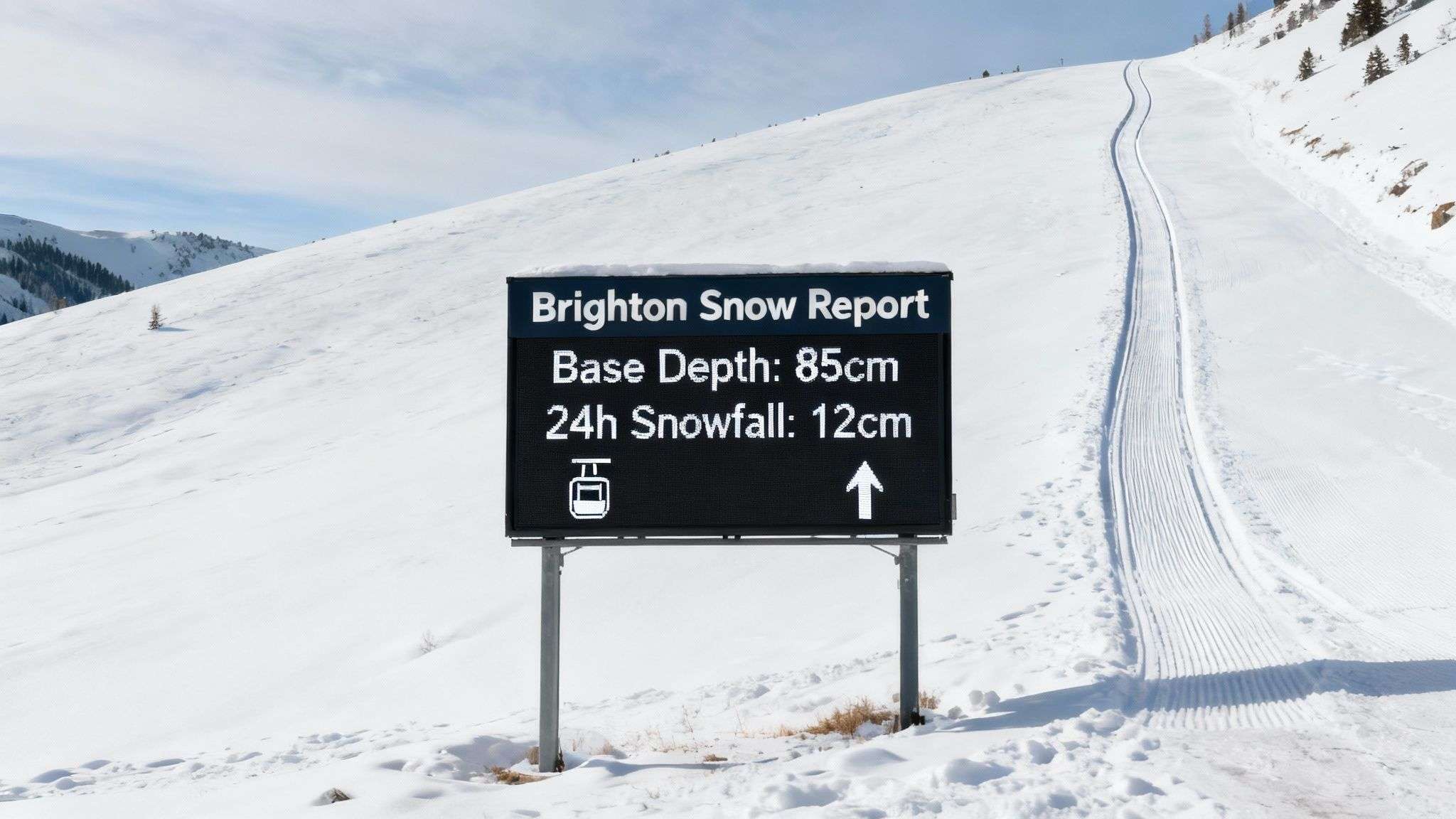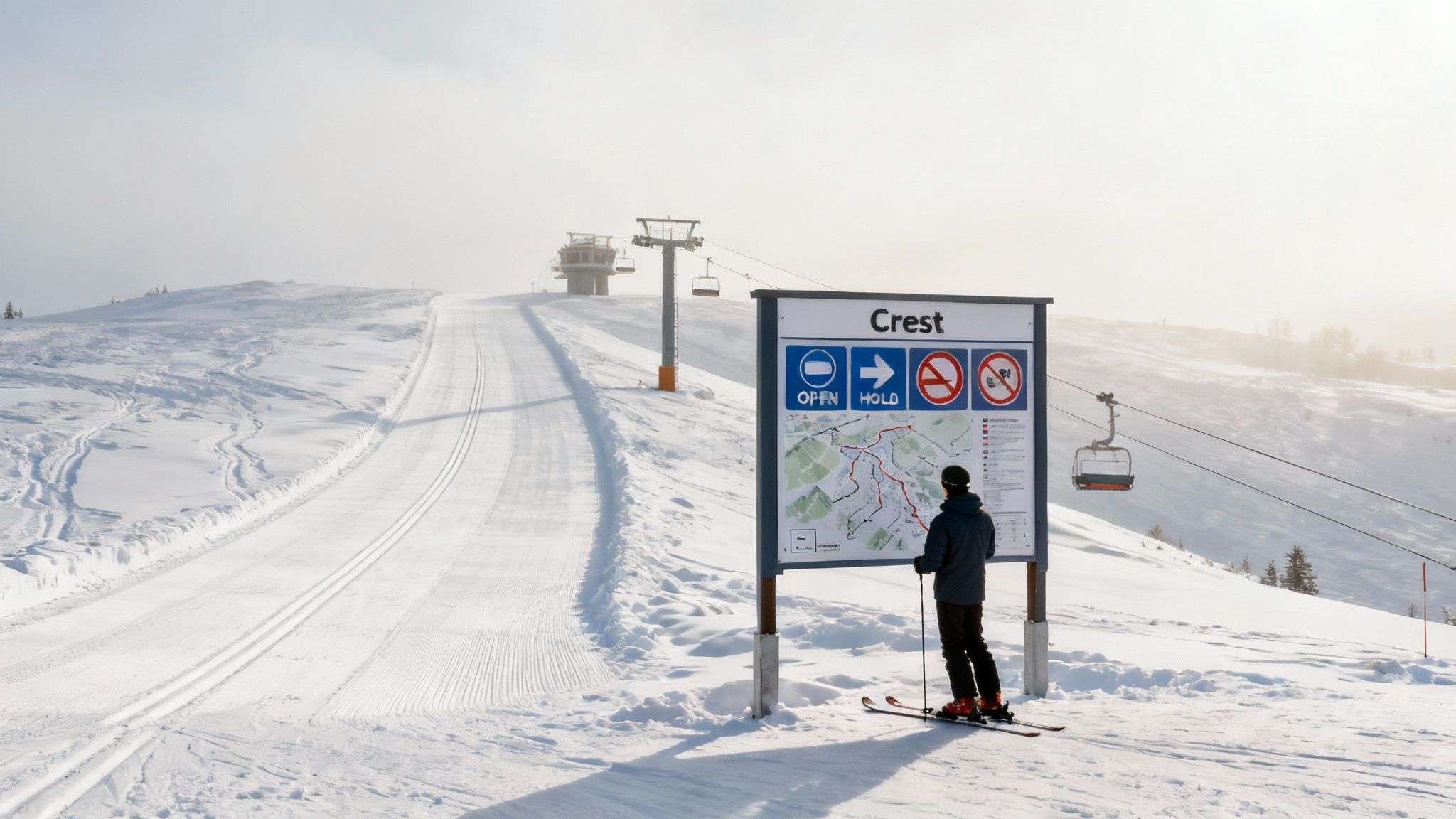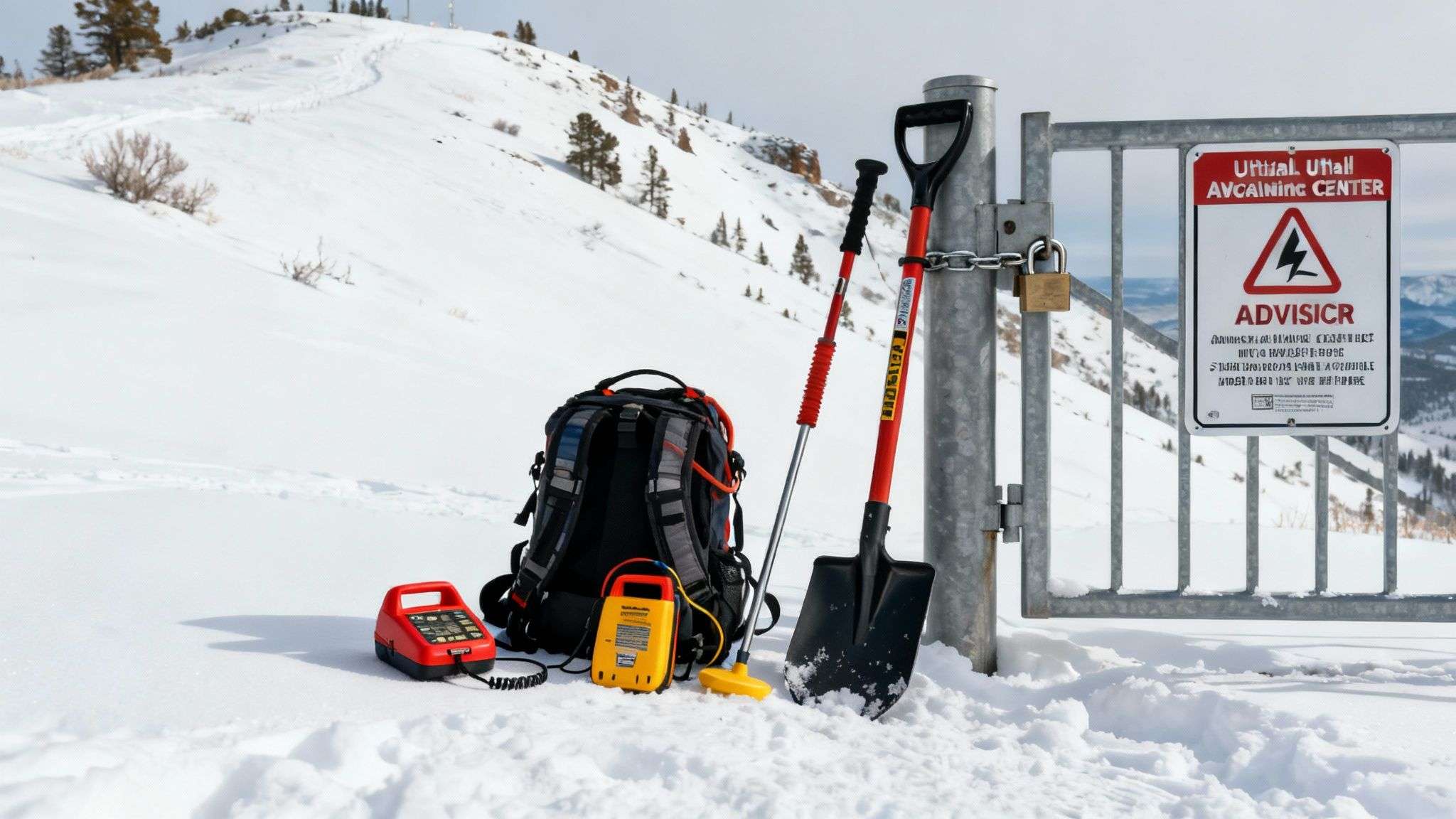Your Live Brighton Utah Snow Report & Conditions Guide
Get the live Brighton Utah snow report with real-time data on base depth, new snow, and lift status. Our guide helps you read the report like a local.
Planning a trip to Brighton Resort? This guide provides the live snow data you need, explains how to interpret it like a local, and offers actionable tips for navigating the mountain and Big Cottonwood Canyon. Get the real-time snow depth, lift status, and weather insights to make the most of your day on the slopes.

What is the Current Snow Report for Brighton?
Knowing the current conditions before you drive up Big Cottonwood Canyon is essential for a great day. Below is the live data from Brighton, covering everything from fresh powder to lift operations. Use this snapshot to dial in your gear and plan your runs.
Brighton Resort Live Data
| Metric | Current Status |
|---|---|
| New Snow (24hr) | 6" |
| Base Depth | 92" |
| Lifts Open | 6 of 7 |
| Runs Open | 62 of 66 |
| Surface Conditions | Powder / Packed Powder |
| Weather | Partly Cloudy, 24°F |
Data is updated in real-time from the resort.
Local Tip: Mountain weather and canyon road status can change instantly. Always cross-reference this snow report with our live Big Cottonwood Canyon road conditions before you leave to ensure a safe and smooth trip from start to finish.
How Do I Read the Brighton Snow Report?
Understanding the daily snow report turns you from a visitor into a savvy local who knows exactly what the mountain offers. The numbers tell the story of the day's conditions, helping you find the best snow and choose the right gear. The two most critical stats are new snowfall and base depth.
Interpreting Snowfall and Base Depth
New snowfall, often reported in 12, 24, and 48-hour totals, tells you how much fresh powder is waiting. Base depth indicates the total settled snow, which is key for overall coverage across the resort.
- New Snow: When the report shows 6+ inches in 24 hours, it's a true powder day. Grab your wider skis or powder board to float on top. If it shows 1-3 inches, conditions will be soft and fun without needing specialized equipment.
- Base Depth: This number tells you what terrain is open and safe to ski.
- Under 50 inches: Early season conditions. Stick to groomed runs, as off-piste areas may have hidden hazards.
- 50-80 inches: Solid coverage across most of the mountain. You can start exploring off-piste terrain with confidence.
- Over 80 inches: Prime season. The entire mountain, including expert terrain off the Crest Express lift, is fully filled in and ready to ski.
Understanding Snow Quality
Depth is only half the story. Look for terms like "powder" (fresh, untouched snow) and "packed powder" (skied-on or groomed snow). Cold temperatures will keep powder light and fluffy, while warmer temperatures can make it heavier as the day progresses.

How Do I Check Brighton's Lift and Trail Status?
Knowing which lifts and trails are open is key to planning your day and avoiding frustrating dead ends. Brighton uses a simple, universal icon system on its website, app, and on-mountain digital boards.
Lift and Trail Status Symbols
- Green Circle (Open): The lift or trail is operating and ready for you.
- Yellow Triangle (On Hold/Standby): A temporary pause, often due to high winds or safety checks. It could reopen at any moment.
- Red Square (Closed): The lift or trail is shut down for the day due to conditions or avalanche mitigation work.
Local Tip: Pay close attention when a lift like Snake Creek Express has a delayed opening after a big storm. This often means ski patrol is finishing avalanche work on slopes loaded with fresh, untouched powder. Being there when the rope drops can lead to the best runs of your day. For road-related operational impacts, check the latest Big Cottonwood Canyon conditions before you go.

When is the Best Time to Ski at Brighton?
While the entire season offers great skiing, certain periods are better for specific conditions.
When to Find the Deepest Snow
If you are chasing deep powder days, January and February are historically the best months. This is when Brighton receives its most consistent storms, building a deep and stable snowpack with light, dry Wasatch powder. However, major storms can happen anytime between December and March, so always watch the Wasatch snow forecast.
On average, Brighton receives 6+ inches of new snow on about 17.8% of its winter days—roughly once every five to six days. You can explore more data on Brighton's snowfall statistics.
When to Check for Avalanche and Backcountry Safety
Before any trip up Big Cottonwood Canyon, you must check the daily avalanche forecast from the Utah Avalanche Center. Even if you stay in-bounds, avalanche conditions impact canyon safety and resort operations. The UAC uses a five-level danger scale from Low to Extreme. The majority of accidents occur during Moderate and Considerable conditions, when the danger is present but not always obvious. Always check the full UAC forecast for the Salt Lake area mountains.

Brighton Snow Report FAQ
How do I check road conditions for Big Cottonwood Canyon?
Before you leave, check the official UDOT Traffic website or the Wasatch Roads Big Cottonwood Canyon summary page for real-time status. During storms, traction laws require 4WD/AWD vehicles with appropriate tires (M+S or snow-rated) or chains for 2WD vehicles.
Where can I find the most up-to-date snow data for Brighton?
The official Brighton Resort website and app provide real-time data on new snowfall, lift status, and grooming. For detailed snowpack analysis, the forecasters at the Utah Avalanche Center offer professional observations. The live data table at the top of this page also provides a quick, reliable snapshot.
How does snow quality change throughout the day?
Snow conditions evolve constantly. After a storm, the best powder is found in the morning before it gets tracked out. On sunny days, south-facing slopes soften in the afternoon, while shaded north-facing slopes preserve colder, chalkier snow for longer. Wind also plays a major role, scouring some areas and depositing deep drifts in others.
At Wasatch Travel Helper, our goal is to give you the real-time road and weather data you need to plan the perfect canyon adventure. Get live traffic updates, camera feeds, and resort conditions all in one place at https://wasatchroads.com.